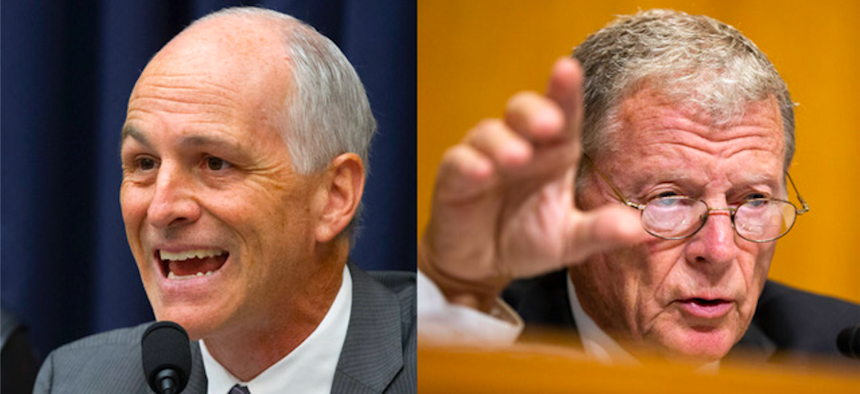
Rep. Adam Smith, D-Wash., left, and Sen. Jim Inhofe, R-Okla., will take control of the House and Senate Armed Services Committees, respectively, in January 2019. AP Photo/Jacquelyn Martin and Manuel Balce Ceneta
The Biggest Difference Between Inhofe and Smith? How Much Danger They Think the US Faces
The incoming SASC chair says “we live in the most dangerous world of my lifetime.” His HASC counterpart calls that “simple paranoia.”
Sen. Jim Inhofe, R-Okla., and Rep. Adam Smith, D-Wash., disagree on a lot of things.
The incoming chairmen of the Senate and House Armed Services Committees have sparred publicly over the size of the budget, the need to upgrade the U.S. nuclear arsenal and the Trump administration’s ban on transgender troops, trading barbs in a series of competing interviews that have served as early markers for the next Congress.
Those individual policy differences rest atop a fundamental schism in worldviews, summed up in their answers to this question: Just how bad are the threats that face America?
Inhofe says that “we live in the most dangerous world of my lifetime,” traveling to the White House earlier this month to urge President Trump not to cut the defense budget for 2020. Smith describes the ouroboros of dire threat assessments and demands for more defense funds as "simple paranoia."
Related: New Armed Services Chair Says He Will Fund Military, Not Drive Foreign Policy ‘Like McCain Did’
Related: Senate Votes to Curtail Yemen Involvement in Rebuke of Trump
Related: What the Midterms Mean for National Security
Take the congressionally mandated report released in November that warned the U.S. faces a “crisis of national security” because its waning military supremacy leaves it unable to fight China and Russia at the same time. The commission, co-chaired by former defense undersecretary Eric Edelman and Gary Roughead, a former chief of naval operations, sparked hearings and debate across Capitol Hill. It argued that budget cuts had damaged the readiness and modernization of the military. And it issued a grim warning about failing to meet the crisis the report describes, arguing that “the costs will be measured in American lives, American treasure, and American security and prosperity lost.” (Edelman served under Bush; Roughead bridged the Bush and Obama administrations.)
“That is the theme of how 90 percent of the people who look at our defense budget look at it—to scare the crap out of you and convince you that we need to spend more money,” Smith said at a recent roundtable with reporters. “Some of that is self-interest, but I think the bulk of it is simple paranoia.
“Yeah, the world is a dangerous place,” he continued. “But what is a sensible approach to that? Is it plausible that the Chinese are going to launch an all-our war against us? Probably not. The Russians? Probably not.”
Inhofe, on the other hand, argues that the general public isn’t frightened enough. The news media, he says, hasn’t done a good job of informing Americans of the seriousness of the threats that the country faces. In particular, he cites a growing Chinese Navy and argues that Chinese and Russian “artillery is better than our artillery.”
“This complacency that the American public is in, I blame the press for,” he said in a recent interview with Defense One. “Why can’t somebody go out there and look at the real threat that they’re facing and tell everybody? Unless somehow people don’t want to believe it?”
Perhaps nowhere is that division more stark than in defense spending. Inhofe has argued that the current budget — $733 billion for 2019 — should be a “floor” not a “ceiling.” For Smith, the answer is deterrence, which he argues can be done efficiently through a more rigorous examination of where the Pentagon is spending the money it already has. The Pentagon recently failed its first audit, although Defense Department officials cautioned that it was not expected to pass.
“There is a mountain of evidence that we can more than survive for less than $750 billion,” he said. “What is sufficient to deter what we don’t want them to do? That’s what we have to look at.
“I tend to think there’s this built-in notion that ‘more is, by definition, better’ and we never quite have enough.”
One example? Smith has called for a smaller nuclear arsenal to serve as a deterrent. Last month, Inhofe said, “What he’s doing is taking the thing that’s singularly the biggest threat to us and saying: ‘We want to make America more vulnerable.’”
In broad strokes, Smith and Inhofe reflect the parties they represent. In the years since the Sept. 11 attacks in New York and Washington, D.C., Americans have consistently ranked defending the United States against terrorism as a top policy priority. But there has also been a clear division between Republicans and Democrats, with the former more likely to say that it should be the top policy priority. (In January, a Pew Research poll found the split was 89 percent of Republicans compared with 64 percent of Democrats.) That partisan split is largely reflected no matter which threat is being discussed. With a few exceptions, such as a nuclear North Korea and cyberterrorism, Republicans were more likely than Democrats to prioritize action on various threats, according to recent Gallup polling.
Both Smith and Inhofe face insurgent elements that are shifting the character of party orthodoxy, and in some cases, pulling it to the margins.
During Smith’s recent primary campaign, he faced an attack from the left, built in part on his vote for defense spending Moreover, a swelling progressive movement across the country has raised the profile of defense spending skeptics like Rep.-elect Alexandria Ocasio-Cortez, D-N.Y. Smith insists that he is not calling for simple cuts to the military — though he acknowledges that some members of his party want them. Noting that that the U.S. spends more on defense than the next seven countries combined is comparing apples to oranges, he says, because the money goes farther in places like China and Russia, which, among other things, do not offer the kind of competitive pay and benefits that U.S. troops get.
Inhofe, meanwhile, takes the gavel as President Trump continues to tap into an ambivalence for American adventurism abroad and multilateral defense organizations like NATO. Although the president has continually boasted that he is building up the military, he has weighed pulling U.S. forces out of Afghanistan and Syria and at one point sparked fears that the United States might pull out of NATO. Inhofe is a staunch ally of the president and it remains to be seen how he might respond to an effort to withdraw U.S. troops, for example. He told Defense One that he would oppose a complete withdrawal from Afghanistan, but said that he did not believe the president would order such a move.
The Armed Services committees have long been seen as a pillar of bipartisanship on Capitol Hill, but growing polarization across the country has left the two leaders with a host of hot-button issues to navigate. A recent survey of foreign-policy opinion leaders ranked polarization as the most critical threat facing the United States. But beyond that, there was little agreement.




